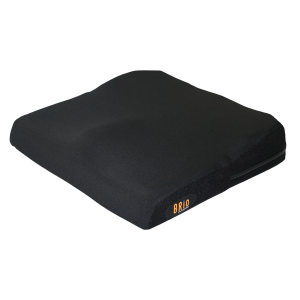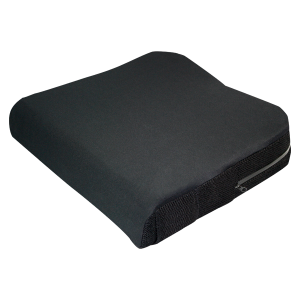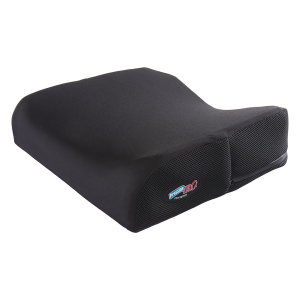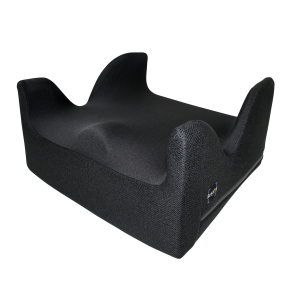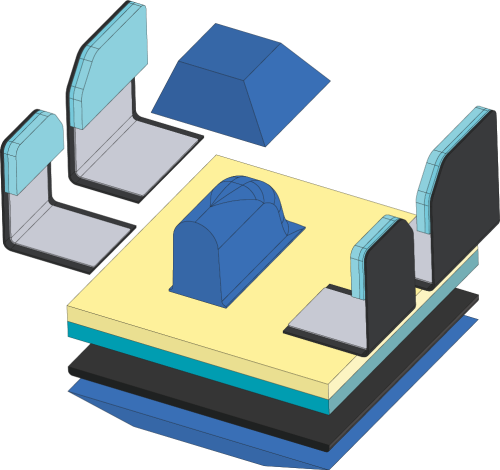
Postural Components
Combined with different options, Physipro™ cushions promote a better balance of posture and increase sitting stability. Many choices of installation, shape and positioning elements are available with each cushion to meet the needs of each morphology as accurately as possible.
Installation Choice

Rigid Seat
For installation on a rigid plate attached to the seat rails, a flat cushion helps keep the seat level and stable.

BUILT-IN
For installation on a rigid plate attached with mounting hooks, the cushion is slightly trimmed at the edges of the base to create space for the seat rails. The bevel shape allows the cushion to be fully integrated into the seat structure.

SLING
For installation on a sling seat , the cushion edges are slanted in order to eliminate hammocking by conforming to the fabric. A reinforced ABS plate
can be added as an option to increase stability.
Customized Shape
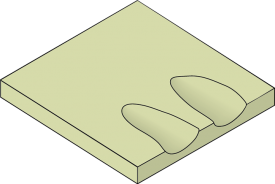
ANATOMIC
The anatomic shape adapts to the natural shape of the body and improves pressure distribution by increasing the contact area. The seat is trimmed at the back to prevent pelvic tilt and two grooves are placed at the front of the cushion to promote a natural alignment of the lower limbs and improve foot propulsion.
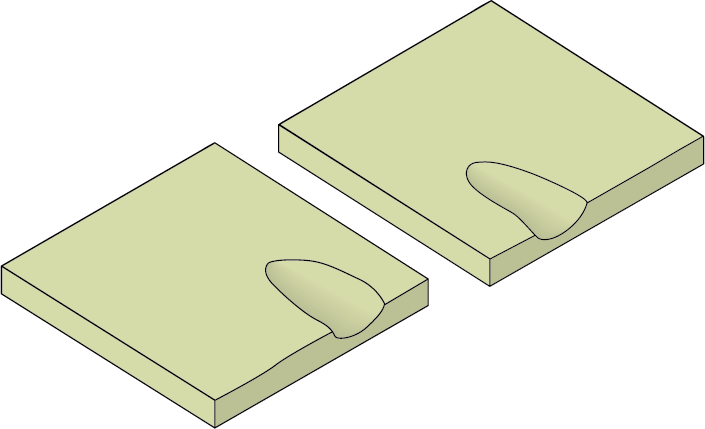
Lowered
The lowered shape is particularly useful in case of hemiplegia. This shape enables the affected limbs to be elevated (therefore creating the effect of an anti-thrust wedge) and facilitate hand-foot propulsion by permitting the functional lower limb to easily contact the floor.
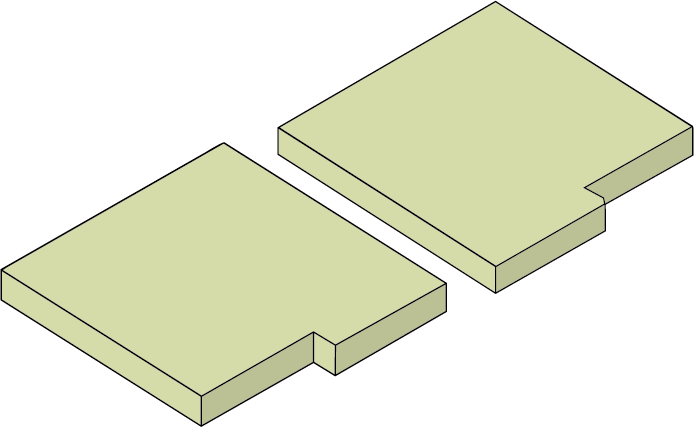
CONTOURED DEPTH
A contoured depth shape is recommended for users with unequal lower limb length. In case involving pelvic rotation, hip dislocation or when single leg propulsion is necessary, the contoured depth shape can meet the user’s needs.

LOW PROFILE
The low profile shape is reduced by 1 inch in the front in order to obtain a lower seat height to facilitates lower limb propulsion and help the user transfers into a standing position.

FRONT WEDGE SHAPE
The front wedge releases pressure at the popliteal fossa area and the hamstrings when the lower limbs are in retraction. The foam is shaped to a bevel at the front of the cushion in order to provide the required clearance.

ROUNDED FRONT
The rounded front decreases pressure caused by a straight cushion at the popliteal fossa area. The foam is slightly trimmed at the front to soften the edge and create a natural curve that conforms to the shape of the back of the knee.
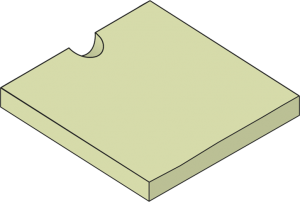
RECESSED SACRAL
The recessed shape at the sacral region is designed to effectively limit contact of high-risk areas during severe pelvic tilt (retroversion). A cut-out at the back of the cushion provides relief for the coccyx.
Postural Components
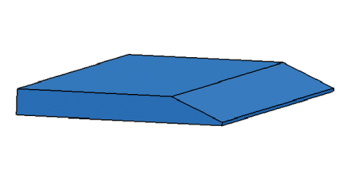
ANTI-THRUST WEDGE
The anti-thrust wedge is installed at the front of the cushion. This postural component prevents sliding, helps manage episodes of spasticity and improves pressure distribution.
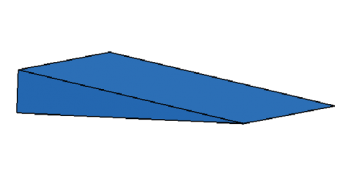
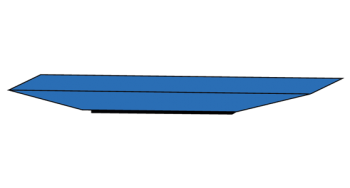
ANTI-SLING WEDGE
Installed directly under the cushion, the anti-sling wedge is used to counter problems caused by the deterioration of a seat cover due to time. The anti-sling wedge protects the user against the development of acute pressure on the legs by transforming the seat into a flat surface.
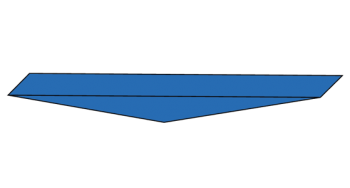
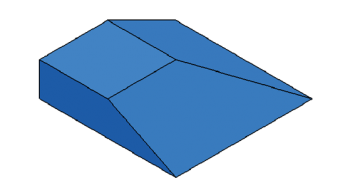
PELVIC OBLIQUITY WEDGE
The pelvic obliquity wedge is used to compensate for loss of gluteal muscle tone and reduce pelvic tilt.
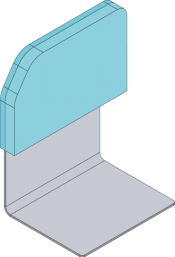
Lateral Thigh Support
The lateral thigh support ensures a better alignment of the lower limbs by limiting the risk of sliding towards the outside of the cushion.
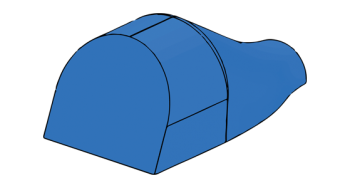
MEDIAL THIGH ABDUCTOR
The medial thigh abductor is used to control the proximity of the lower limbs (adduction) and ensure proper alignment of the body by increasing the distance between the lower limbs.
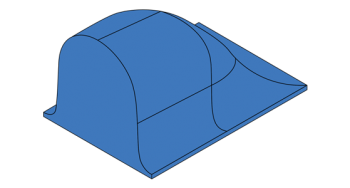

LATERAL PELVIC SUPPORT
The lateral pelvic support is used to reduce lower limb abduction and limit pelvic movement. Removable or fixed inside the cushion, this postural component can also be used to fill the space caused by a pelvic tilt.
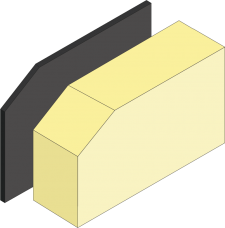
Installation Choice Specification
| Flat | N/A |
| Built-In | 1″, 1 ½″ ou 2″ |
| Sling | ABS Rigidizer available |
Customized Shape Specification
| Anatomic | 1″ Lowering |
| Lowered | 1″ Lowering |
| Contoured Depth | 1″ or 2″ Depth of withdrawal |
| Low Profile | 1″ Lowering |
| Front Wedge Shape | 2 ½″ Clearance |
| Rounded Frontal Shape | N/A |
| Recessed Sacral Shape | N/A |
Postural Components Specifications
| Anti-Thrust Wedge | 1″, 1 ½″ or 2″ thick |
| Anti-Sling Wedge | 1″, 1 ½″ or 2″ thick |
| Pelvic Obliquity Wedge | Dimension (W x D) : 6″ x 6″, 8″ x 8″ or 10″ x 10″ 1″, 1 ½″ or 2″ thick |
| Lateral Thigh Support | Dimension (H x D) : 2″ x 4″, 3″ x 5″ or 4″ x 6″ ¾″ thick |
| Shaped Medial Thigh Abductor | Dimension (W x D) : 2 ½″ x 3″, 3″ x 4″ or 3 ½″ x 5″ 3″, 4″ or 5″ thick |
| Velcro Medial Thigh Abductor | Dimension (W x D) : 2″ x 5″, 3″ x 7″, 4″ x 7″ or 5″ x 7″ 2″, 2 ½″ or 3″ thick |
| Shaped Lateral Pelvic Support | Dimension (D x H) : 6″ x 3″, 7″ x 4″ or 8″ x 5″ ¾″ thick |
| Standard Lateral Pelvic Support | Dimension (D x H) : 9 ½″ x 5 ½″ Composition : Firm urethane of 1″, 1 ½″ or 2″ |
| Non-Standard Lateral Pelvic Support | Composition : urethane ½″ or 1″, plastazote ¼″ or ½″ or memory foam ½″ or 1″ Sizes and thickness of your choice |

